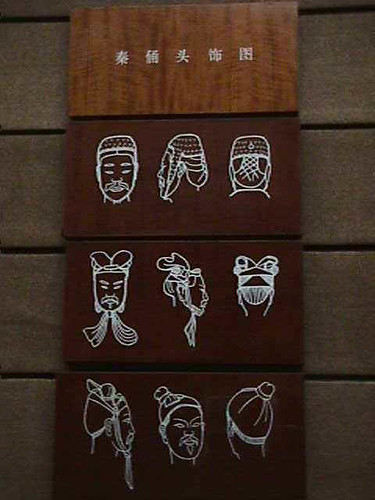Bingmayong

The Terracotta warriors (bingmayong) are among the top archaeological excavations of the 20th Century. This incredible collection of 6,000 men and their horses was actually discovered completely by accident by a group of peasants in 1974 who were digging a well! In a bizarre twist, the man who supposedly discovered them now sits in a hall at the site signing postcards of the stone army. The Terracotta Warriors represent only a small portion of the eight thousand strong underground army buried in front of the Emperor Qinshihuang's tomb (r. 221-207 BC) to defend him in the afterlife.
 T
The craftsmanship attested by each of the statues is as stupendous as the scale of the project. So who was the Emperor Qinshihuang to merit such magnificence?

One of the most important rulers in Chinese history, this Emperor leaves a legacy as morally complicated as that of Peter the Great. For, like the Russian Tsar, he is as well-known for his contributions to the modern state as he is for sacrificing the lives of thousands of laborers to his visionary projects. Made King of the state of Qin at the age of thirteen, by the time he was thirty-eight he conquered the six neighboring states to unify China for the first time.

Although reviled for his tyranny, Qinshihuangdi is also admired for many radical and insightful policies which subsequent dynasties employed. To synthesize seven separate states into one nation, he standardized a common script and established uniform measurement and monetary systems. For effective government, he codified a legal system and replaced hereditary rulers with a centrally appointed administrative system. To improve industrial productivity he encouraged agricultural reforms and constructed many roads. And in an effort to limit the inroads of barbarian tribes, he supervised the construction of a defence fortification along the northern frontier, the first Great Wall. Although China benefited from these policies, thousands of Chinese workers died in completing this far-reaching public works program.
700,000 forced laborers were sacrificed to construct his tomb which was begun as soon as he ascended the throne. All workers and childless concubines were interred with him to safeguard its secrets. According to Sima Qian's "The Historical Records" written a century later, heaven and earth are represented in the tomb's central chamber. The ceiling, inlaid with pearls, represents the starry heavens. The floor, made of stone, forms a map of the Chinese kingdom; a hundred rivers of mercury flow across it. And all manner of treasure is protected by deadly booby-traps.
The main tomb (where archaeologists believe possibly a larger and more impressive army is buried) has still to be excavated - partly because archaeologists are still uncertain of its exact location. Often Emperors amassed huge burial mounds simply to divert robbers' attention from the true site of their tomb. So the artificial mound that today marks the Emperor's tomb does not necessarily indicate the location of its wondrous central chamber. However, because high mercury levels have recently been reported nearby, archaeologists think they may, at last, have discovered it. The Terracotta Warriors, that you will see today, form just one of the many barriers the ruthless Emperor employed to protect his tomb for eternity.
The limestone and marble Kouroi and Kourai of the Greek Late Archaic Period (535-480 BCE) refute the claim that the Terracotta Warriors were the first free-standing statues in the history of world art. This, though, does little to undermine the ingenuity of the Terracotta Warriors' design and manufacturing process.
 For whereas the Ancient Greeks meticulously carved individual statues out of stone, the Qin dynasty project held all the problems of production on a mass scale. Tens of thousands of individual human and animal statues were manufactured within a series of processes that began with the molding of solid legs.
For whereas the Ancient Greeks meticulously carved individual statues out of stone, the Qin dynasty project held all the problems of production on a mass scale. Tens of thousands of individual human and animal statues were manufactured within a series of processes that began with the molding of solid legs.

It was by constructing each of the hollow statues upon solid legs that the Ancient Chinese craftsemen solved the perplexing problem of how to make a statue free-standing. Hollow heads, arms and legs, made of coiled earth, were joined together with strips of clay and set upon the solid legs. After this rough model was assembled, a fine clay slip was added, and details such as eyes, mouth, nose and details of dress were carved into the clay while it was still pliable. Additional pieces such as ears, beard and armour were modeled separately and attached, after which the whole figure was fired at a high temperature.
Sources: CHINAPICTURES.ORG (most images are taken from that web site)
Archeology.net
Chinatravelclub.com/topsight/10.asp



2 Comments:
damn!!
i want to go there right now! :(
--zahid
wow.
Post a Comment
<< Home